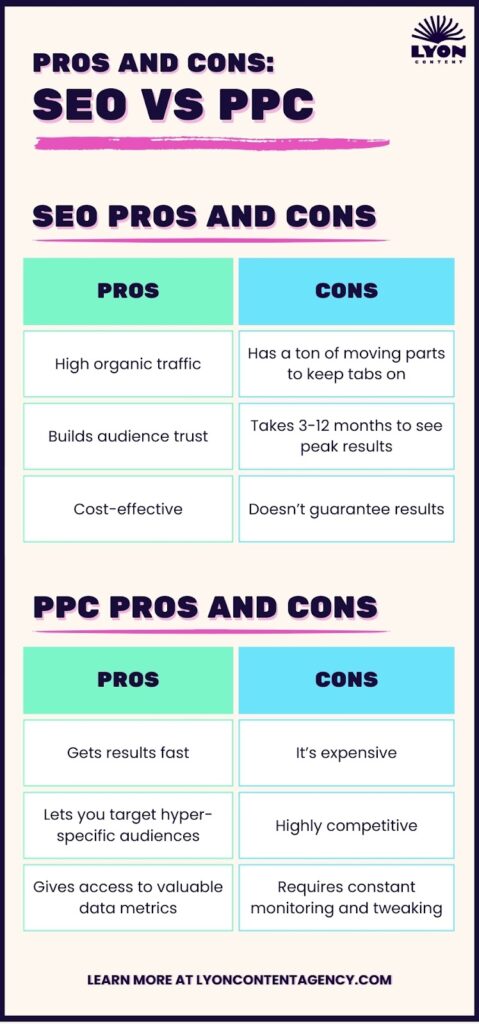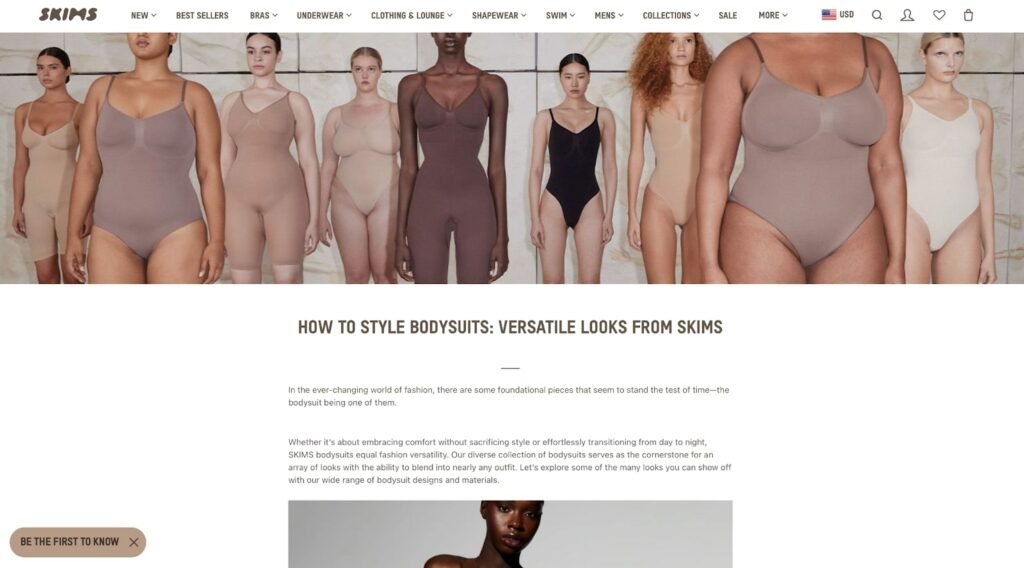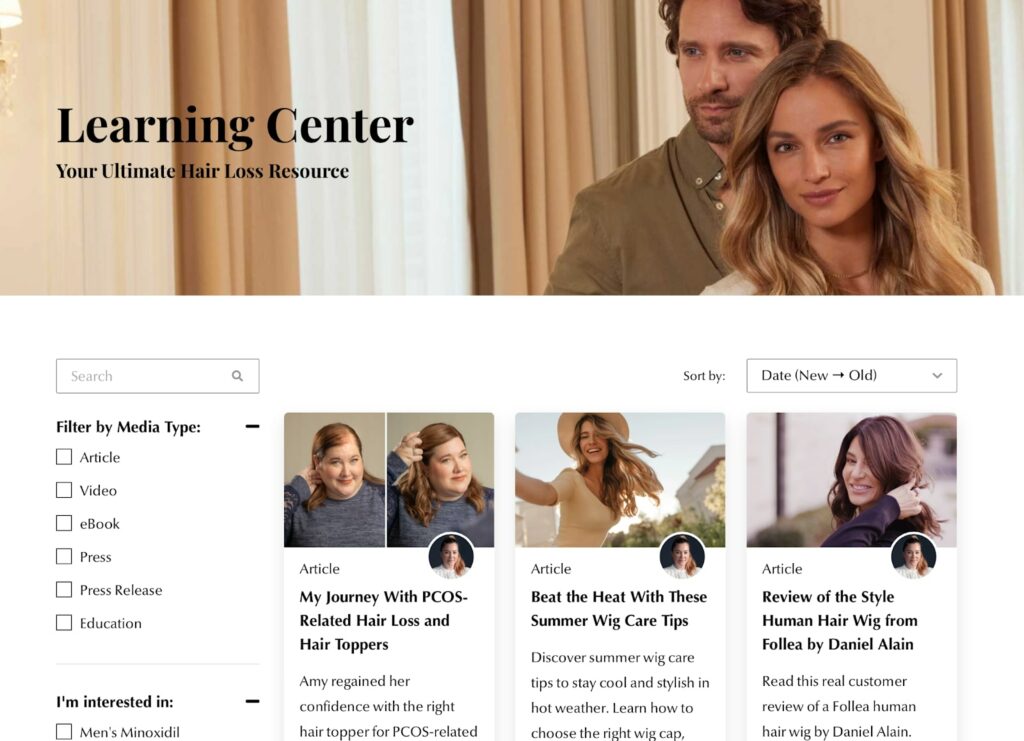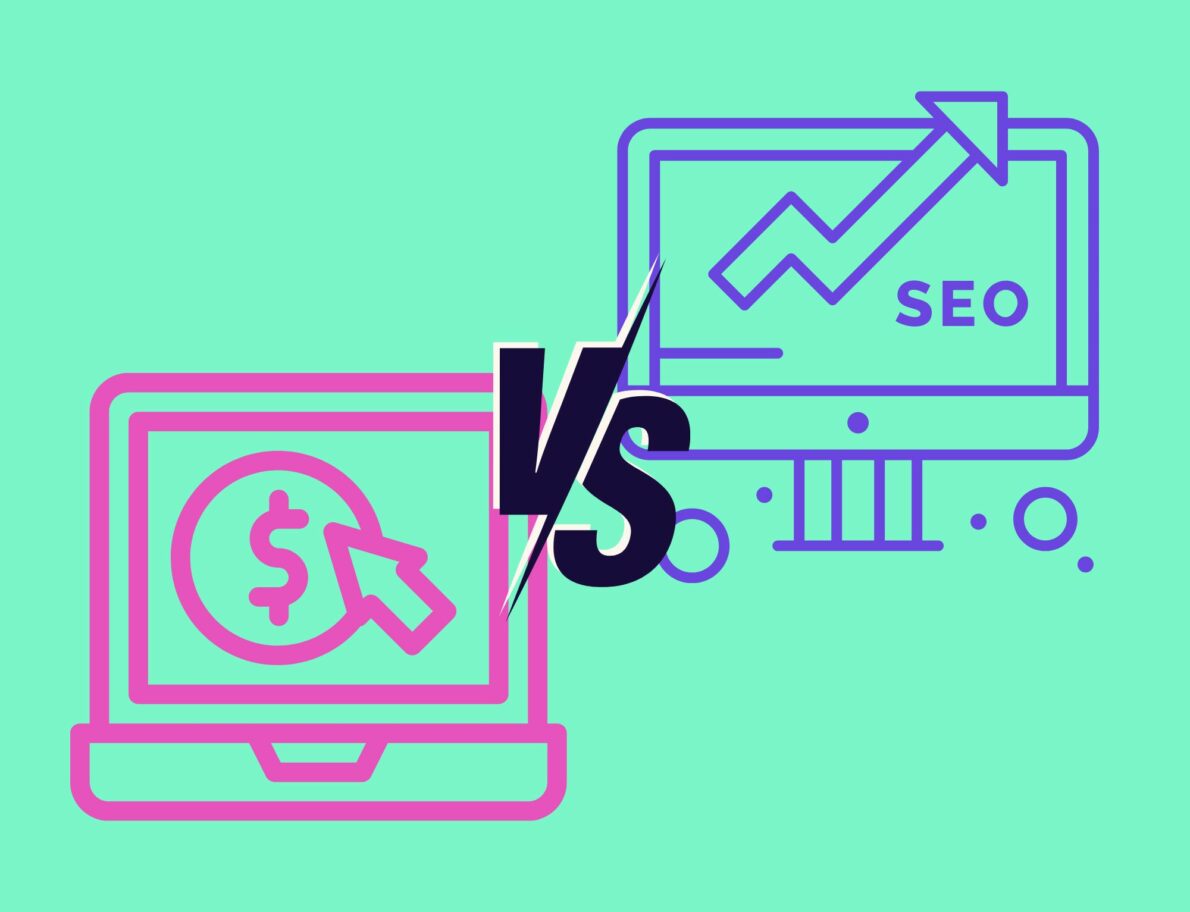Every brand craves more website traffic, sales, and loyal customers. And to get it, they often turn to marketing. This ultimately leads to the great SEO vs PPC debate. Should you proceed with organic or paid marketing?
Search engine optimization (SEO) and pay-per-click (PPC) advertising are two digital marketing tactics get your brand’s content on organic search results and in front of your audience. SEO vs PPC both drive traffic to your website, just in different ways. So which is right for your business?
In this guide, our SEO guru Kim Fischer breaks down the difference between SEO vs PPC, key differences, pros and cons of each, and how to harness both for a kickass marketing strategy that brings you revenue.
Defining SEO and PPC
SEO vs PPC appeal to search engine algorithms in different ways. SEO focuses more on long-term growth for your online presence, while PPC search ads are quicker, pricier ways to score some conversions.
What is SEO?
SEO is a long-term process of optimizing your content and web pages to help search engines like Google and Bing rank it in organic search results. The goal? Convince search engines that your content is superior to your competitors and rank high on the search engine results page (SERP).
There are four key spokes in the wheel of SEO:
- Keyword research – Identify and include search terms and queries people type into search engines
- Technical SEO – Make your site user-friendly, crawlable, indexable, and error-free
- On-Page SEO – Create content that matches what your target audience searches for
- Off-Page SEO – Boost authority with backlinks, interviews, and news
Here’s how it looks in action:
First, you need to determine which search terms your audience types into Google, and their intent is behind those searches.
Then, you need to create relevant, logical, and engaging content that describes those search terms, and update it regularly.
On top of that, you’ll need to consider SEO updates from Google to make sure you meet their guidelines for acceptable and rankable content.
Overall, SEO is a long process but over time, it builds niche authority, brand awareness, and organic traffic that contribute to sales in the long run.
But what about a faster track to results with SEO vs PPC?
What is PPC?
PPC ads appear as sponsored posts at the top of the SERP, before organic SEO search results. You bid on keywords and set daily budgets to dictate how much you spend. Ad rankings depend on your keyword relevance, audience targeting criteria, and how much you bid compared to your competitors.
When we say PPC, we primarily mean Google Ads and Bing Ads (and that’s what we’ll focus more heavily on in this article).
However, social media platforms like Instagram and Facebook also use PPC-structured ads that appear on their home pages (sponsored posts).
“Think about PPC as a pay to play strategy,” Kim proposes. “Play your cards right, and you’re the first results for your best keyword. However, when you stop, you immediately stop getting results.”

Organic SEO vs PPC Comparison: Pros and Cons
So, what’s the main difference between SEO vs PPC?
“PPC is often more at the bottom of the funnel; people have a problem, and they want it solved NOW,” Kim says. “But it can work for both problem- and solution-aware keywords. SEO can be anywhere in the funnel and has more problems with unaware users as well.”
Pros of SEO
SEO is the best way to win your audience’s hearts with consistent, engaging content. Here’s why:
1. Most web traffic comes from SEO
WebFX shares that nearly half of website traffic comes from SEO. That’s more than social media campaigns and PPC ads combined! While PPC ads show up higher on the SERP, they don’t always generate the most traffic because some audiences find organic SEO results more trustworthy, especially if they’re just looking for information and not ready to buy.
SEO content also tends to appeal to top-funnel audiences, which are people interested in learning more about a topic without pulling the trigger on a purchase. This audience is broader, with plenty more keyword opportunities to target, albeit not always ones that indicate a quick sale.
Still, this is your chance to:
- Entertain your audience: Ever searched up home remedies for an ailment? You probably loved diving through listicles for inspo and learning about all your options. Let your audience enjoy your content the same way before pushing a sale.
- Help them get to know you: Share your brand values with authentic storytelling and knowledgeable content about your industry.
- Indulge in your passion: You love your products and industry — chances are, your audience will be able to tell through your content.
Here’s a great example from shapewear brand, Skims:

Ladies, have you ever hit a snag when trying to style a bodysuit? Skims made this article just for you. Notice they don’t aggressively sell their products to you in this blog post. Sure, they feature ideas — but the premise is to help you gain inspo on ways to style bodysuits in general. That’s what the keyword target speaks to as well (how to style bodysuits):

If you scroll down to the end, you’ll see a linked CTA that invites readers to explore Skims’s products. And based on the fact that Skims is worth over $4 billion? We’ll bet readers clicked that link at the end.
2. SEO builds audience trust
Think about the last thing you purchased. How long did it take for you to decide on that purchase? Chances are, you needed to get more familiar with the brand before you opened your wallet.
This is especially true for audiences with more sensitive needs or issues. For example, we partnered with our alternative, luxury hair client Daniel Alain on their SEO strategy and wrote targeted blog posts.
This company’s customers (primarily women) all faced physical and emotional struggles that came with hair loss.
Unfortunately, the $7 billion alternative hair industry is filled with low-quality products that cause audiences to lose trust. The solution? Foster genuine connections with their audience with helpful, honest, relevant, engaging, and accurate content.

3. SEO is cost-effective
We won’t sugarcoat it: PPC campaigns are expensive and cost nearly $10,000 per month or more for many brands.
SEO vs. PPC, on the other hand, doesn’t charge you per click. The content you create only costs the labor it takes to create and optimize it, which makes SEO an affordable marketing strategy for many brands.
While exact SEO costs depend on your staff, content volume, and agency costs, you can expect to spend an average of $3,000 per month compared to the steeper average $10,000 of PPC campaigns.
Cons of SEO
1. SEO has a lot of moving parts
SEO is a labor of long-term love, but we should stress the importance of the “labor” part. Ahrefs found that 96.55% of online content gets zero traffic from Google. That’s a result of many factors, like:
- Not updating content: Proud of your blog article on 2023 industry stats? It’s 2024, so Google’s search engine algorithms expect a more recent update, if not a completely new article.
- Failing to consider Google’s updates: We heard about the E-E-A-T (Experience, Expertise, Authoritativeness, and Trustworthiness) update at the end of 2022, when Google stressed the importance of these elements in your content. But a quick browse shows plenty of more recent updates from the last two years, like the April 2023 reviews update or June 2024 spam update. If you don’t reflect these updates in your SEO strategy and your competitors do, they might outrank you in the SERP.
- Limited time: We don’t need to see your Google calendar to know your days as a brand owner are absolutely slammed. And if you don’t have a full-fledged marketing team on-staff, it’s easy to delay vital keyword research, blog writing, content updates, and technical tweaks to keep your SEO strategy operating smoothly.
Let’s face it: SEO is like a stage-five clinger Hinge-match that needs your constant attention.
And if you don’t have the time for it? Leave it to an award-winning content marketing agency like Lyon Content to handle the details for you! Just drop us a line to get started.
2. SEO takes a while to gain momentum
Looking for a quick fix to your slumped sales numbers this quarter? Unfortunately, SEO isn’t the answer — at least not for quick results.
“For businesses with local clients, it typically takes 3-6 months to see success,” says Kim. “On the other hand, for online-only businesses, it may take 6 months to 1 year to see significant results.”
3. SEO doesn’t guarantee results
Solid SEO always generates website traffic. But technically, those results aren’t actually guaranteed the same way PPC ads guarantee traffic.
Think of it like this: hiring your content marketing team to create SEO content is an investment but there is no promised spot on the SERP. Whereas with PPC, the money you spend always results in at least a click to your site.
Still, neither of these promise revenue, which is why it’s so important to create the right ads and content for your specific audience.
Pros of PPC
PPC campaigns win serious points for brands, like quick results, detailed audience targeting, and valuable data insights.
1. PPC gets you results fast
PPC campaigns get you significant website traffic and conversions within 2-3 months — a step up from SEO’s 3-12 months. If traffic is your primary goal in the SEO vs PPC debate, this is a great place to start.
2. You can target specific audiences
SEO ranks content based on keyword research, while PPC ads show up for keywords and audience targeting criteria. This is a serious plus for brands with specific audiences they want to advertise to. You can target audiences in PPC campaigns based on:
- Demographics: Google lets you target based on age range (18-24, 65+, etc.), gender, and household income for all campaign types, as well as marital and parental status for exclusively display and demand-gen campaigns.
- Interests and habits: Want to capture audiences that regularly watch or follow makeup lessons on YouTube? Sounds like a hobby that you can target with Google’s affinity segments, where the search engine aggregates multiple data points for their algorithms to target affinities accurately.
- Online behavior: Did your audience recently visit your social media page or website? Target them by online behavior and website history, a great tool for ad personalization and remarketing campaigns.
3. PPC campaigns give you access to valuable data
Next time you run a PPC campaign, take a peek at your Google Analytics dashboard. The sheer depth and volume of audience data will blow you and your marketing strategy away.
Even with a failed PPC campaign, the performance insights generated can help you improve your next campaign and overall marketing strategy.
For example, say you had 400 clicks on your ad. You can see where those clicks came from (location of your audience) and which devices they used to access your content (smartphone versus desktop computer). PPC campaigns also lend themselves to A/B testing, which tests individual ad elements like title, keywords, or landing page visuals to tell you what clicks more with your audience.
Cons of PPC
Every digital marketing tactic has its drawbacks, and PPC ads are no exception:
1. PPC is expensive
On average, brands spend between $9,000 and $10,000 on PPC campaigns and management. Why so high? Well, you pay for literally every click, meaning even if audiences visit your website and don’t make a purchase — you still have to pay. Plus, cost per click (CPC) is higher for certain industries than others.
Check out these average CPCs below by industry:
- Legal: $6.75
- Consumer services: $6.40
- Tech: $3.80
- Real estate: $3.44
Think of it this way. Say you’re a tech company and you generate 100 clicks in your ad campaign. Three people visited your website, and only one purchased a product. To get that purchase, you still had to pay at least $380.
And this isn’t unlikely for certain industries like tech. If you like at average clickthrough rates (CTRs) in the Wordstream article linked above, tech brands see an average 3.09%. That’s a tiny percentage of people who actually clicked on the ad.
2. PPC campaigns are competitive
With PPC ads, you rank higher when you pay a higher price tag. But for some industries, it’s never high enough. Thousands of brands compete for high-volume keywords just like you, and if they have a bigger marketing budget? You’ll struggle to keep up and your ad spend might not get you the visibility and results you thought they would.
Kim shares that profitability with PPC depends on many factors, like:
- Price point of your product or service
- Ad budget each month
- Industry or niche
But Kim says there is hope:
“Small businesses can be really successful with ads if they target really specifically.”
3. They require constant monitoring
Even if your PPC campaign brings you 1,000 sales in one week, you can’t expect the same the following week. Why? Because optimal daily budgets, bid amounts, and keyword targets could change over time. That’s why you need to constantly monitor your PPC performance to make sure your account structure is in tip-top, converting shape.
Hang on — don’t PPC campaigns offer automated bidding strategies to optimize them for you?
Yes, and you should definitely explore them. But remember, your audience is human, which means machine learning and AI can only go so far in appealing to them. You’ll need a human touch to make sure your brand values and business goals are still intact within an automated strategy.
Smoke the Competition with Lyon Content’s SEO and PPC Copywriting!
SEO vs PPC: which is better? According to Kim, it depends on your marketing goals. But the secret to a sustainable content strategy is a medley of the two:
“SEO is a long game that snowballs; the more you do, the more content you create, the more you can rank for, and you can stay ranking for years,” she explains. “PPC is a great way to jump-start or help build brand awareness because audiences will see you at the top [of the SERP] always.”
And if you show up for paid and organic results? Your organic links are more likely to get clicked.
Ready to elevate your SEO and PPC game? Our savvy content writers and marketing strategists are ready to bat for you in the SERP. Let’s talk.

07/16/2024
Chrissy is a contributing writer at Lyon Content based in Toronto. She loves writing and editing tech, marketing, and lifestyle content. But her favorite part of writing is helping businesses express themselves. When she isn't writing, she's traveling as much as possible and eating a lot of cheese.





